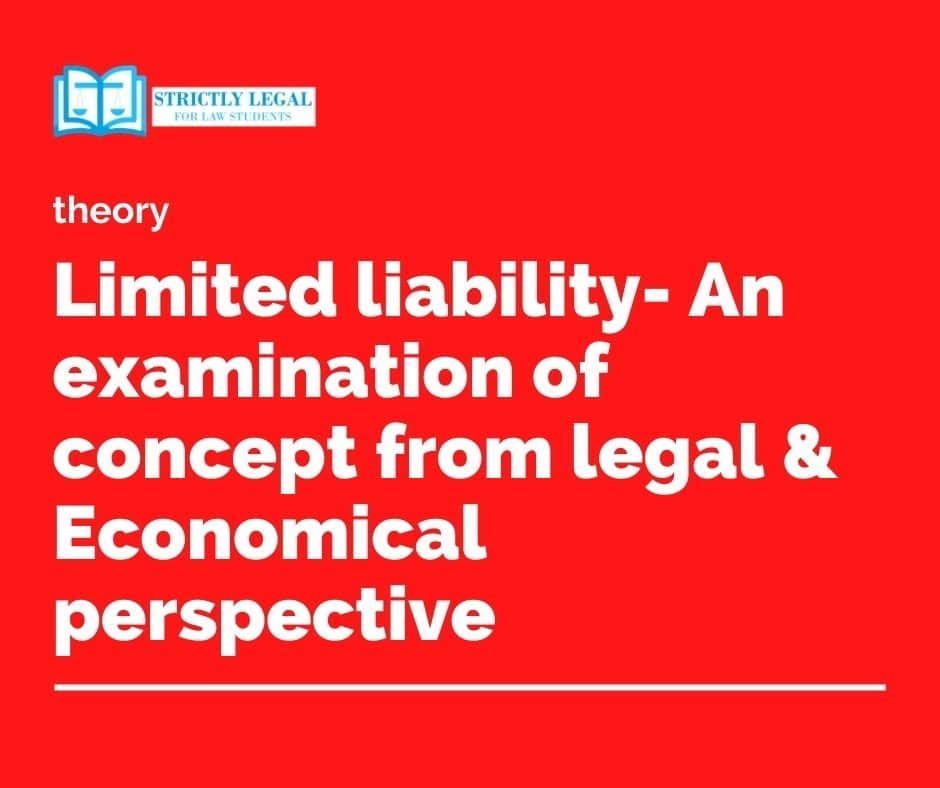This essay will will concisely discuss about the concept of limited liability and specifically point out the economic and legal perspective.
Table of Contents
Concept
Limited liability refers to the enabling provision of law that limits a member (or shareholder’s) liability towards the organisation and makes a clear demarcation between personal assets and the organisation’s assets. It saves the member or shareholder from liquidation of it’s personal assets in case the organisation defaults on its debts to third parties such as creditors.
Limited liability in India majorly exists in two forms.
1. Limited liability Partnership Act, 2008
2. Companies Act, 2013
Legal Aspect
In other words, this system of risk management is prevalent in Partnership and Company form of business.
Under the Limited Liability Partnership Act, 2008
28. Extent of liability of partner (1) A partner is not personally liable, directly or indirectly for an obligation referred to in sub-section (3) of section 27 solely by reason of being a partner of the limited liability partnership. (2) The provisions of sub-section (3) of section 27 and sub-section (1) of this section shall not affect the personal liability of a partner for his own wrongful act or omission, but a partner shall not be personally liable for the wrongful act or omission of any other partner of the limited liability partnership.
Under the Companies Act, 2013
4. Memorandum [(1) The memorandum of a company shall state—
(d) the liability of members of the company, whether limited or unlimited, and also state,—
(i) in the case of a company limited by shares, that liability of its members is limited to the amount unpaid, if any, on the shares held by them; and
It should however be noted that not all companies registered under the Companies Act or Partnership form of business is of limited liability. The provisions are such that enables the promoters of the entity to suit a form of liability that matches their business needs.
Limited liability may sometimes be regarded as a tool to skip responsibility or commit fraud because it provides a prominent protection against unlimited liability to its members but certain provisions have been placed as a safeguard to protect the creditors against such malafide acts.
In the case United States v. Milwaukee Refrigerator Transit Company, it was stated “A corporation will be looked upon as a legal entity, as a general rule, and until sufficient reason to the contrary appears; but, when the notion of legal entity is used to defeat public convenience, justify wrong, protect fraud, or defend crime, the law will regard the corporation as an association of persons.”
A through investigation into the ‘extent of liability’ an organisation imposes on its members should be studies before its incorporation. Because the meaning of limited liability is not just limited to the entity’s liability but also to the responsibility of it’s members towards its creditors and towards other shareholders.
Economic Aspect
Limited liability system developed quickly,and has occupied the dominant position in the form of business enterprises. It is a big leap in modern day business enterprise form, and could very well be the greatest inventions based on the economic purpose, creates a lot of productivity, proves the value of its existence . But just as every coin has two sides, it plays the positive function one side, but it can’t avoid another pair of contradiction. The paradox of one side is the limited liability of shareholders, the other is the interests of the creditors, customers and other stakeholders.
Limited liability enables greater investment opportunities both to individual investors and itself. That means, investors can invest in a company and thereby become members without having to risk their personal assets and at the same time this enables the business entity to accept more investments and push its economies of scale.
However, this comes with certain risks and limitations. Limited liability increases the risks of the creditors. The creditors will now have to make precise predictions as to the viability of their lending as limited liability increases the risks of default and such an action will bring in managerial interference in the organisation and their increased risks will also increase the interest rates leading to inefficiencies in business operations.
Conclusion
A considerable decision must be reached after weighing the various pros and cons of Limited liability. It is both a great tool for scaling a business entity and a booster for the economy. At the same time, brings with itself a higher risk. Limited liability remains one of most preferred form of business that dominate the modern organisational landscape.

Passionate about using the law to make a difference in people’s lives. An Advocate by profession.





